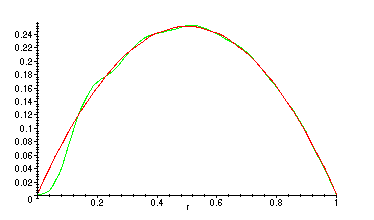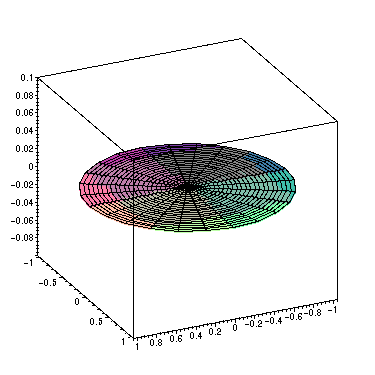MATH 373 -- Applied Mathematics (PDE)
April 26, 2001
A Boundary Value Problem for the 2D Wave Equation
Circular Membrane:
0 <= r <= a, 0 <=
![]() <=
<=
![]()
We will solve the following problem
![]()
![]()
![]()
![]()
The solution will be a "linear combination" of the fundamental
modes we saw last time. Because the initial displacement is
0 for all
![]() only the "cos - sin" and "sin - sin" forms are
only the "cos - sin" and "sin - sin" forms are
necessary. Moreover, because of the form of the initial
velocity, we see that only terms with
![]() are
are
necessary. This means that the expansion will contain only
terms with m = 3. (For more general initial positions and
velocities, terms with more, even infinitely many, different
m values would be necessary.)
We have
![[Maple Math]](images/CD29.gif) ,
,
where
![]() is the
n
th positive zero of the Bessel function
is the
n
th positive zero of the Bessel function
![]() .
.
To find the coefficients
![]() , we will use the orthogonality properties
, we will use the orthogonality properties
of the functions
![[Maple Math]](images/CD213.gif) . Because these are eigenfunctions
. Because these are eigenfunctions
of the self-adjoint Sturm-Liouville operator
![[Maple Math]](images/CD214.gif) (the 9 equals
(the 9 equals
![]() ), we know that
), we know that
if
![[Maple Math]](images/CD216.gif) , then
, then
![[Maple Math]](images/CD217.gif) .
.
whenever m <> n. It then follows as usual that in order to find
the expansion of a given
![]() in terms of these eigenfunctions,
in terms of these eigenfunctions,
we will have:
![[Maple Math]](images/CD219.gif) , when
, when
![[Maple Math]](images/CD220.gif)
The resulting expansion is called the Fourier-Bessel series for f .
In our problem, taking
![]() =
=
![[Maple Math]](images/CD222.gif)
we see that
![[Maple Math]](images/CD223.gif) as above, so
as above, so
![[Maple Math]](images/CD224.gif)
![[Maple Math]](images/CD225.gif)
To generate a plot, we take
a =
1, c
=
1,
![]()
> a := 1; c := 1;
![]()
![]()
> alpha := r -> r*(1-r);
![]()
> c := n -> evalf(Int(alpha(r)*BesselJ(3,BesselJZeros(3,n)*r/a)*r,r = 0 .. a)/Int(BesselJ(3,BesselJZeros(3,n)*r/a)^2*r,r = 0 .. a)):
> B := n -> a*c[n]/(c*BesselJZeros(3,n)):
As always, to plot, we need to consider a finite partial sum of the Fourier-Bessel
series. How good is our approximation to
![]() ?
?
> plot({alpha(r),add(c(n)*BesselJ(3,BesselJZeros(3,n)*r/a),n=1..10)},r=0..1);

A corresponding partial sum for the series solution of the wave equation:
> PS := k -> add(B(n)*BesselJ(3,BesselJZeros(3,n)*r/a)*sin(3*theta)*sin(c*BesselJZeros(3,n)*t/a),n=1..k);
Warning, `n` in call to `add` is not local
![]()
> PS5:=PS(5):
> with(plots):
> animate3d([r*cos(theta),r*sin(theta),PS5],r=0..a,theta=0..2*Pi,t=0..2,frames=30,view=-0.1..0.1,axes=BOXED);
